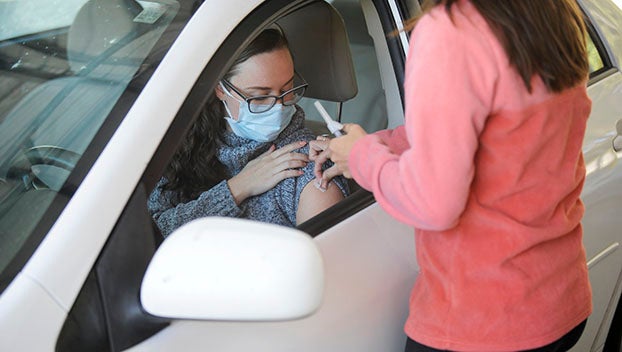Report lists county’s health statistics, priorities
Published 7:49 pm Wednesday, July 7, 2021

- (Brandon Tester / Daily News)
|
Getting your Trinity Audio player ready...
|
The Beaufort County Health Department recently shared the 2020 State of the County Health Report, which provides a look at the area’s demographics, health statistics, initiatives and areas of focus.
The 2020 report references data from the 2018 Community Health Assessment, which is published every three years. The health department is currently working on its 2021 Community Health Assessment, which is expected to include more information about the impact of COVID-19 on Beaufort County.
The 2018 Community Health Assessment shows that the leading cause of death among Beaufort County residents from 2014-16 was cancer (415 deaths), followed by heart diseases (403), chronic lower respiratory diseases (109), accidental injuries (105), cerebrovascular diseases (98), Alzheimer’s disease (66), diabetes (64), kidney diseases (34), hypertension (32) and suicide (29). The rankings of those causes of death in Beaufort County are largely consistent with the rankings in North Carolina as well as the cumulative rankings of the 33 counties in the nonprofit program Health ENC.
Within the Community Health Assessment, 25 indicators were used to identify areas for improvement in Beaufort County. That helped narrow the list down to four top priority issues: access to care; exercise, nutrition and weight; education; and substance abuse.
In the State of the County Health Report, the health department explained how the county is working toward addressing those areas of focus.
On the topic of access to care, the report says the primary care provider rate for Beaufort County is 48 providers per 100,000 people. The mental health provider rate is 107 providers per 100,000 people.
“Both of which are behind the North Carolina rate, which just shows we probably have a hard time getting to the doctor’s office, or there’s too long of a wait, or there’s too many people to be seen at one time, and usually we have to end up waiting,” said JaNell Octigan, the health department’s human services and preparedness coordinator.
In the report, the health department said it has expanded the hours of its healthy living clinic from four hours per week to one-and-a-half days per week, extended its Women, Infants and Children hours on Tuesdays until 6 p.m. and added behavioral health services. Health department services are offered on a sliding fee scale based on income.
Obesity is a significant part of the exercise, nutrition and weight topic. The Community Health Assesment revealed that one out of every three Beaufort County residents is obese, and 48.3% of county residents said a health care professional informed them that they were overweight.
“The reason that’s important is a lot of those things tie directly to our heart disease rates, our diabetes (rate), which is highly reported, even cancer and stroke,” Octigan said. “So we really want to tackle nutrition, excersize and weight so that hopefully in the end we can lower our stroke rates, our cancer rates, diabetes and much more.”
In the report, the health department explained several initiatives it has in place to deal with those issues — including its Diabetes Prevention Program, Diabetes Self Management Education and Medical Nutrition Therapy, as well as the department’s community walking trail that serves as a way to increase exercise opportunities.”
On the topic of education, the health department has used its resources to help local schools implement safe practices and handle other challenges associated with the pandemic.
The health department has also implemented health education classes within Beaufort County Schools. A public health education specialist teaches sexual health courses to freshmen at Southside, Northside and Washington high schools.
The hope is that the department can help contribute to a higher graduation rate within the county.
Countywide, the percent of residents 25 or older with a high school degree or higher (84.6%) is slightly lower than the state value (86.3%) and the Health Eastern North Carolina (ENC) region (84.7%),” the report reads. “ In Beaufort County, only 18.6% of residents 25 and older have a bachelor’s degree or higher, which is lower than the state value of 29.0% and the regional value of 19.9%. … According to the Office of Disease Prevention and Health Promotion, high school graduation leads to lower
rates of health problems as well as a reduced risk for incarceration. Receiving a bachelor’s degree opens up career opportunities in a variety of fields and is often a prerequisite for higher-paying jobs.”
As for substance misuse, the report says Beaufort County has one of the highest opioid prescription rates in North Carolina.
“The equivalent of every man, woman, and child in Beaufort County could receive over 69 opioid pills each, while the state average is around 43 pills per resident,” the report says. “According to the NC Injury and Violence Prevention
Branch, Beaufort County had 9 unintentional opioid overdose deaths in 2019. The county’s unintentional medication and drug death rate per 100,000 is 21.5, which is greater than the NC rate of 16.7. In 2019, the most common opioids resulting in emergency department visits included heroin, prescription opioids, and synthetic
narcotics (fentanyl).”
The report references local anti-substance abuse initiatives such as the health department’s syringe exchange program, which began in July 2019. Since 2019, 602 syringes were collected, 41 syringe exchange participants were enrolled, 128 doses of Naloxone/Narcan were distributed and 170 syringe exchange program kits were distributed.
The State of the County Health Report also includes a timeline of the COVID-19 pandemic, stretching from December 2019 to January 2021. The complete report and the 2018 Community Health Assessment can be viewed here.





